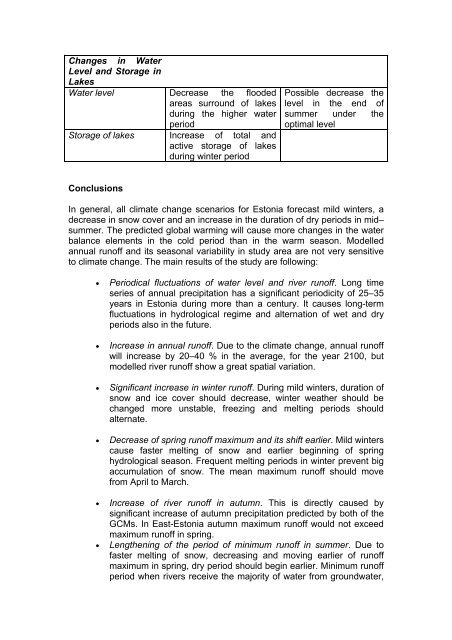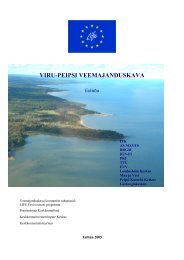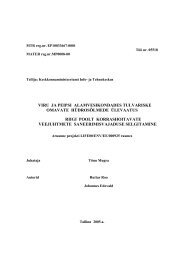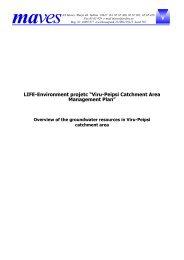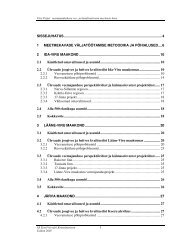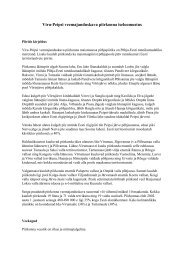open file - Viru Peipsi
open file - Viru Peipsi
open file - Viru Peipsi
You also want an ePaper? Increase the reach of your titles
YUMPU automatically turns print PDFs into web optimized ePapers that Google loves.
Changes in Water<br />
Level and Storage in<br />
Lakes<br />
Water level Decrease the flooded<br />
areas surround of lakes<br />
during the higher water<br />
period<br />
Storage of lakes Increase of total and<br />
active storage of lakes<br />
during winter period<br />
Possible decrease the<br />
level in the end of<br />
summer under the<br />
optimal level<br />
Conclusions<br />
In general, all climate change scenarios for Estonia forecast mild winters, a<br />
decrease in snow cover and an increase in the duration of dry periods in mid–<br />
summer. The predicted global warming will cause more changes in the water<br />
balance elements in the cold period than in the warm season. Modelled<br />
annual runoff and its seasonal variability in study area are not very sensitive<br />
to climate change. The main results of the study are following:<br />
• Periodical fluctuations of water level and river runoff. Long time<br />
series of annual precipitation has a significant periodicity of 25–35<br />
years in Estonia during more than a century. It causes long-term<br />
fluctuations in hydrological regime and alternation of wet and dry<br />
periods also in the future.<br />
• Increase in annual runoff. Due to the climate change, annual runoff<br />
will increase by 20–40 % in the average, for the year 2100, but<br />
modelled river runoff show a great spatial variation.<br />
• Significant increase in winter runoff. During mild winters, duration of<br />
snow and ice cover should decrease, winter weather should be<br />
changed more unstable, freezing and melting periods should<br />
alternate.<br />
• Decrease of spring runoff maximum and its shift earlier. Mild winters<br />
cause faster melting of snow and earlier beginning of spring<br />
hydrological season. Frequent melting periods in winter prevent big<br />
accumulation of snow. The mean maximum runoff should move<br />
from April to March.<br />
• Increase of river runoff in autumn. This is directly caused by<br />
significant increase of autumn precipitation predicted by both of the<br />
GCMs. In East-Estonia autumn maximum runoff would not exceed<br />
maximum runoff in spring.<br />
• Lengthening of the period of minimum runoff in summer. Due to<br />
faster melting of snow, decreasing and moving earlier of runoff<br />
maximum in spring, dry period should begin earlier. Minimum runoff<br />
period when rivers receive the majority of water from groundwater,


